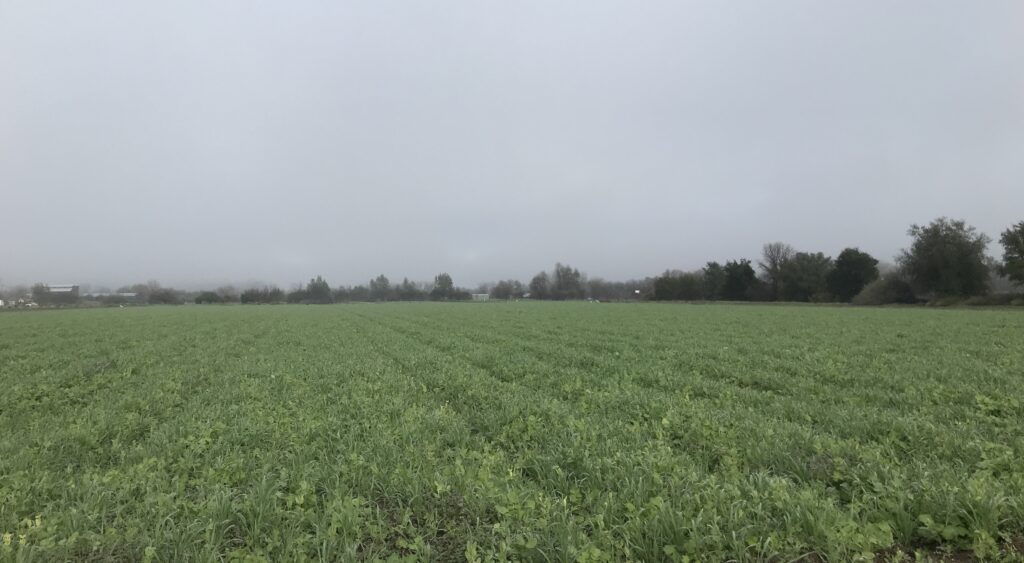
It’s amazing what some rain can do. In the fall, a bit of rain washes off the layer of dirt and dust and rejuvenates everything. That kind of rain isn’t enough to refill our streams or turn the hills green – that’s what the winter rains are for. At this point, the hills around us are green again, a welcome site after months of brown. Most fields are also green – the cover crops have germinated and are chugging along, despite the cold and wet days, and relatively little sunlight.

Over the last week, depending on when you looked outside however, you might have struggled to see much of anything. We’ve had some very low clouds and fog, shrouding everything in layers of grey and white – low rain clouds on a rainy day (like Saturday) and very low fog on other days (like Sunday).
Looking at the farm on a foggy morning feels like thinking about the year ahead. After 40 years of operation, we know what to expect, but it’s a little murky. Each year is different and undoubtably we’ll get some curveballs and some surprises, good and bad. How much rain will we get? Any serious freezes during crucial fruit and nut flowering periods? How many really hot days this summer? Which crops will do well? Which ones won’t? The answers are (mostly) out of our control and only time will tell!

Eventually the fog of uncertainty will lift and we’ll have our answers, but not until we’re in the thick of it, and maybe not until this time next year, when things slow down and there’s time to look over the numbers. I took a look at last year’s CSA data and wanted to share some numbers with you.
Last year, we packed about 58,500 CSA boxes over our 48 week season. Our flower team bunched about 6,100 CSA bouquets and 800 bunches of tulips. WOW!
And what was in those boxes? If you got a box every week:
- 44 bunches of leafy greens (arugula, bok choi, raab, chard, collards, kale, mizuna, and spigarello)
- 27 weeks of potatoes
- 26 bunches of carrots
- 16 weeks of citrus
- 14 weeks of lettuce or salad mix
- 13 weeks of summer squash
- 13 weeks of melons
- 11 bunches of broccoli
- 12 cabbage
- 10 winter squash – 1 acorn squash, 4 butternut, 2 kabocha, 2 spaghetti squash, and 1 pumpkin
- 9 bunches of beets
- 8 weeks of tomatoes (heirlooms, early girls, and cherry tomatoes)
- 8 weeks of peppers
- 8 weeks of peaches
- 7 weeks of eggplant
- 6 rutabaga (it was a really good year for rutabaga!)
- 6 bunches of radishes
- 6 weeks of grapes
- 6 weeks of cucumbers
- 6 fennel
- 5 weeks of corn
- 4 weeks of asparagus
- 4 weeks of pomegranates
- 3 weeks of green beans
- 3 weeks of quince
- 2 bunches of basil
- 1 week of persimmons
- okra at least once!
And much more!
While we are always looking and planning far ahead, we also do often look back on past seasons as a guide of what to expect. I’m very curious how things will look different this year. Last year was a VERY wet and cold winter and spring and everything was behind schedule. Annual crops went in the ground late, or grew really slowly. Perennial crops were three to four weeks late. We had less time to harvest many summer crops that we would’ve in a more “normal” year.
As Judith wrote a few years ago when she tallied the previous years’ box contents “Overall, it’s clear that the CSA box brings a great diversity of fruits and vegetables into the kitchen. Sometimes it may require a spirit of experimentation to figure out how to cook everything and other times you may have to repeat a recipe here and there with vegetables that are repeated.” The breakdown of produce may have changed, but her statement still holds true. And when you have a favorite recipe, a storage or prep tip, or just really enjoy something, let us know!
Elaine Swiedler, CSA Manager
